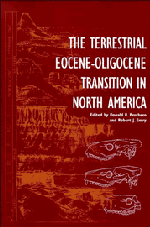Book contents
- Frontmatter
- Contents
- Contributors
- Preface
- PART I The Chronostratigraphy of the Uintan through Arikareean
- 1 Magnetic stratigraphy and biostratigraphy of the middle Eocene Uinta Formation, Uinta Basin, Utah
- 2 Biostratigraphy and magnetostratigraphy of the Bridgerian-Uintan Washakie Formation, Washakie Basin, Wyoming
- 3 Magnetic stratigraphy, sedimentology, and mammalian faunas of the early Uintan Washakie Formation, Sand Wash Basin, northwestern Colorado
- 4 Theoretical biochronology, the Bridgerian-Uintan boundary and the “Shoshonian Subage” of the Uintan
- 5 Middle Eocene mammalian faunas of San Diego County, California
- 6 Stratigraphy and paleomagnetism of the middle Eocene Friars Formation and Poway Group, southwestern San Diego County, California
- 7 Magnetostratigraphy of the upper middle Eocene Coldwater Sandstone, central Ventura County, California
- 8 Stratigraphy and paleomagnetism of the upper middle Eocene to lower Miocene (Uintan to Arikareean) Sespe Formation, Ventura County, California
- 9 Magnetostratigraphy of the Eocene-Oligocene transition in Trans-Pecos Texas
- 10 Magnetic stratigraphy of the Duchesnean part of the Galisteo Formation, New Mexico
- 11 Stratigraphy and vertebrate faunas of the Bridgerian-Duchesnean Clarno Formation, north-central Oregon
- 12 Eocene-Oligocene faunas of the Cypress Hills Formation, Saskatchewan
- 13 Magnetic stratigraphy of the White River Group in the High Plains
- 14 Magnetostratigraphy and biostratigraphy of the Eocene-Oligocene transition, southwestern Montana
- 15 The Whitneyan-Arikareean transition in the High Plains
- PART II Common Vertebrates of the White River Chronofauna
- Summary
- Index
12 - Eocene-Oligocene faunas of the Cypress Hills Formation, Saskatchewan
Published online by Cambridge University Press: 06 July 2010
- Frontmatter
- Contents
- Contributors
- Preface
- PART I The Chronostratigraphy of the Uintan through Arikareean
- 1 Magnetic stratigraphy and biostratigraphy of the middle Eocene Uinta Formation, Uinta Basin, Utah
- 2 Biostratigraphy and magnetostratigraphy of the Bridgerian-Uintan Washakie Formation, Washakie Basin, Wyoming
- 3 Magnetic stratigraphy, sedimentology, and mammalian faunas of the early Uintan Washakie Formation, Sand Wash Basin, northwestern Colorado
- 4 Theoretical biochronology, the Bridgerian-Uintan boundary and the “Shoshonian Subage” of the Uintan
- 5 Middle Eocene mammalian faunas of San Diego County, California
- 6 Stratigraphy and paleomagnetism of the middle Eocene Friars Formation and Poway Group, southwestern San Diego County, California
- 7 Magnetostratigraphy of the upper middle Eocene Coldwater Sandstone, central Ventura County, California
- 8 Stratigraphy and paleomagnetism of the upper middle Eocene to lower Miocene (Uintan to Arikareean) Sespe Formation, Ventura County, California
- 9 Magnetostratigraphy of the Eocene-Oligocene transition in Trans-Pecos Texas
- 10 Magnetic stratigraphy of the Duchesnean part of the Galisteo Formation, New Mexico
- 11 Stratigraphy and vertebrate faunas of the Bridgerian-Duchesnean Clarno Formation, north-central Oregon
- 12 Eocene-Oligocene faunas of the Cypress Hills Formation, Saskatchewan
- 13 Magnetic stratigraphy of the White River Group in the High Plains
- 14 Magnetostratigraphy and biostratigraphy of the Eocene-Oligocene transition, southwestern Montana
- 15 The Whitneyan-Arikareean transition in the High Plains
- PART II Common Vertebrates of the White River Chronofauna
- Summary
- Index
Summary
ABSTRACT
The Cypress Hills Formation of southwestern Saskatchewan preserves fossil mammals of Uintan (middle Eocene) to Hemingfordian (early Miocene) age. Deposition was nearly continuous during this interval, and the widely held belief that a limited period of Uintan sedimentation on the Swift Current Plateau was followed by Chadronian sedimentation throughout the area, the two separated by a period of non-deposition, is incorrect. Eocene assemblages from the Cypress Hills Formation have aided in identifying the profound middle Eocene faunal turnover as taxonomic displacement, and in documenting the greatly increased faunal provinciality of the Duchesnean. Late Eocene and Oligocene assemblages, many of them newly discovered, provide a rare opportunity to trace the evolution and eventual replacement of the White River Chronofauna in the northern Great Plains. The classic concept of the “Cypress Hills Oligocene” is based on Chadronian to Hemingfordian specimens collected from a large geographical area, and must be abandoned in favor of a model involving many successive local faunas. The local fauna most similar to the “Cypress Hills Oligocene” of the literature is the middle Chadronian (late Eocene) Calf Creek Local Fauna.
INTRODUCTION
The Cypress Hills Formation of the Swift Current and Cypress Hills Plateaus (Figs. 1, 2), southwestern Saskatchewan, preserves a series of mammalian paleofaunas representing middle Eocene to early Miocene time. Uintan to Chadronian local faunas in the Swift Current Plateau and Chadronian to Hemingfordian assemblages in the Cypress Hills Plateau furnish a unique opportunity to trace the evolution of mammals in the northern Great Plains through the period of profound middle Eocene faunal replacement, much of the history of the White River Chronofauna, and into the beginnings of the Miocene Chronofauna.
- Type
- Chapter
- Information
- The Terrestrial Eocene-Oligocene Transition in North America , pp. 240 - 261Publisher: Cambridge University PressPrint publication year: 1996
- 14
- Cited by

